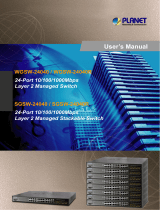
TABLE OF CONTENTS
CHAPTER 1: SWITCH MANAGEMENT OVERVIEW......................................................................................................3
CHAPTER 2: Getting Started..........................................................................................................................................4
Network with DHCP server:...........................................................................................................................................4
Smart Wizard Discovery > Discover.......................................................................................................................... 4
Smart Wizard Discovery > Web Access.................................................................................................................... 5
Web Management...................................................................................................................................................... 6
Network without DHCP server................................................................................................................................... 6
Smart Wizard Discovery > Configuration Setting > Default....................................................................................... 7
CHAPTER 3: Software Upgrade Procedure................................................................................................................11
CHAPTER 4: Smart Wizard Discovery Utility Program .............................................................................................13
Main Screen.................................................................................................................................................................13
Main Screen > Device List > Discover..................................................................................................................... 15
Main Screen Switch Setting > Configuration Setting.............................................................................................. 16
Main Screen > Switch Setting > Password Change................................................................................................ 16
Main Screen > Switch Setting > Web Access.......................................................................................................... 17
Main Screen > Switch Setting > Firmware Upgrade................................................................................................ 18
Main Screen > Switch Setting > Exit........................................................................................................................ 18
CHAPTER 5: Configuring the Device Using YOUR BROWSER................................................................................19
Getting Started......................................................................................................................................................... 20
Opening the NETGEAR Home Page for the FS700TS-Series Switch.................................................................... 20
Understanding the Home Page ............................................................................................................................... 21
Using The NETGEAR Web Management System Buttons..................................................................................... 22
Device Management Buttons................................................................................................................................... 24
Resetting the System............................................................................................................................................... 25
Defining Device Information.........................................................................................................................................26
Viewing the Device Zoom View............................................................................................................................... 26
Viewing the Device Status...........................................................................................................................................27
Managing Stacking.......................................................................................................................................................29
Operation Modes ..................................................................................................................................................... 29
Understanding Stack Topology................................................................................................................................29
Stacking Ring Topology........................................................................................................................................... 29
Stacking Ports.......................................................................................................................................................... 30
Stacking Members and Unit ID................................................................................................................................30
Removing and Replacing Stacking Members.......................................................................................................... 30
Inserting a Stacking Member................................................................................................................................... 31
Exchanging Stacking Members............................................................................................................................... 31
Switching the Stacking Master................................................................................................................................. 31
Configuring Stacking................................................................................................................................................ 32
Configuring Device Security.........................................................................................................................................34
Defining Port Authentication Properties.......................................................................................................................34
Defining Port Authentication.................................................................................................................................... 36
Viewing EAP Statistics............................................................................................................................................. 38
Enabling Storm Control............................................................................................................................................ 40
Port Security ............................................................................................................................................................ 42
Configuring Passwords............................................................................................................................................ 44
Viewing System Logs...................................................................................................................................................45
Logs Configuration................................................................................................................................................... 46
Viewing the Memory Logs........................................................................................................................................ 48
Viewing Flash Logs.................................................................................................................................................. 49
Defining Server Logs ............................................................................................................................................... 50
Page 1






















